| Teams: New York Giants | Largest Crowd: 14,364 |
| Opening Day: July 8, 1889 | Closing Day: September 13, 1890 |
| Dimensions: CF 360 | Surface: grass |
| Location: Southern half of Coogan's Hollow between 155th & 157th Streets |
Memorable Moments:
- 1889 National League Pennant.
- May 12, 1890 a homer hit by NL Giant Mike Tiernan landed in Brotherhood Park. Both parks cheered.
- September 14, 1889, Giants center fielder George Gore couldn't climb the muddy embankment. As a result Chicago's Cap Anson stretched a double into an inside the park home run.
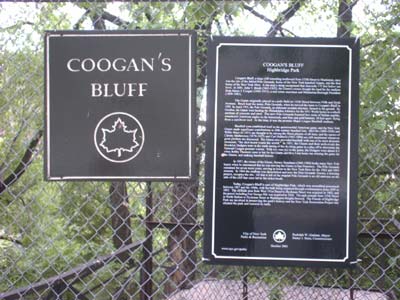
Click here to read the above sign
The Giants moved here after the city confiscated the original Polo Grounds. Polo was never played here. Anyway the site known as Coogan's Hollow held two parks. This one and one used by the Players League New York Giants known as Brotherhood Park. The only thing separating the two fields was a steep dirt embankment and a canvas covered wooden fence. This park had the steepest and largest embankment ever used in the majors. After a year or so, the Players League fell apart and the National League Giants moved into the larger park. The park was until the 1930s by Haitian cricket players.
| Teams: New York Giants (NL 1891-1911)), New York Giants (PL 1890) | Largest Crowd: 38,805 |
| Opening Day: April 19, 1890 | Closing Day: April 13, 1911 |
| Dimensions: LF 277 CF 433 RF 258 | Surface: grass |
| Location: Northern half of Coogan's Hollow between 157th & 159th Streets |
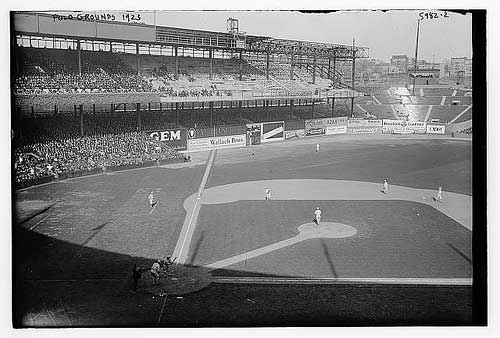
Memorable Moments:
- June 4, 1890: Tim Keefe gets his 300th win.
- 1905 World Series Champion.
- 1904 National League Pennant.
"An absurd and lovely thing." This quote belongs to Roger Angell. This incarnation of the Polo Grounds was certainly absurd. This was the only park in the Majors, other than League Park in Cleveland, where a ball hit into the stands but a ball hit higher and further in the same direction was still in play. Also since this park was situated at the bottom of hill, surrounded by trees and buildings, many would be patrons just saw the game for free. The center field bleacher were named Burkeville or the cigar boxes for the Irish immigrants who sat there.
As I noted above the largest crowd was about 39,000. On October 8, 1908, a quarter of a million people showed up. This was for a replay of the September 23 game in which the Cubs protested New York winning because even though Harry McCormick scored from third, the run should not have counted because Fred Merkle didn't touch second Al Bridwell's game winning single to center. Umpire Hank O'Day witnessed Cubs infielder Johnny Evers tag second for the force. Anyway, National League President Harry Pulliam upheld O'Day's call later that evening and ordered a replay. Since Chicago and New York were tied this replay was essentially a pennant game. When all of the people showed up they tried to storm the field but the police held everyone back. A few people got injured, one fireman was killed, and many other ticket holders couldn't even get in because of the crowd. The Cubs could not practice because the crowd was so hostile, and when they won 4-2, fans cause the NYPD to draw guns because they tried to storm their club house. All in all it was a ridiculous day. Ah well, New York, New York.
Anyway, this park will be destroyed by a fire in April of 1911. Only the bleachers and outside wall will survive. The stands will be reinforced with concrete and used in the new structure.
| Teams: New York Giants, New York Yankees, New York Mets | Capacity: 56,000 |
| Opening Day: June 28, 1911 | Closing Day: September 18, 1963 |
| Dimensions: LF 279 CF 483 RF 258 | Surface: grass |
| Architect: Henry B. Herts and Osborn Engineering |
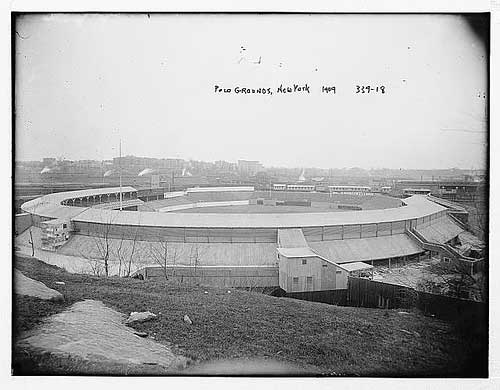
Memorable Moments:
- 1911 - 1913, 1917, 1921 - 1923 (won), 1924, 1933 (won), 1936, 1937, 1951, 1954 (won) World Series.
- The entire 1921 and 1922 World Series were played at this stadium (Giants vs. Yankees).
- 1934 and 1942 All Star Games.
- June 28, 1912: Christy Mathewson wins his 300th game.
- September 20, 1924: Pete Alexander wins his 300th game.
- August 1, 1945: Mel Ott hits his 500th home run.
- Game 1 of the 1946 Negro League World Series.
- October 3, 1951, 4:11 P.M. Eastern Time, vs. the Dodgers, Bobby Thomson hit the "Shot Heard Round the World" to end "The Greatest Game Ever Played".
- September 29, 1954: The Catch, by Willie Mays.
A.K.A.: Brush Stadium (1911 - 1919), Coogan's Bluff, Coogan's Hollow, Matty Schwab's house, Harlem Meadow.
Teams:
- New York Giants - played from 1911 - 1957 when they moved to San Francisco.
- New York Yankees - played from 1913 - 1922 when the Giants owner was threw them out for drawing more fans.
- New York Mets - played from 1962 - 1963 when Shea Stadium was built.
Roger Angell also wrote "It's the only ballpark built against a cliff - Coogan's Bluff - so that a patron could walk downhill to a seat. You came slowly down the John T. Brush stairs to the cool of the evening, looking down at the flags and the tiers of brilliant floodlights on the stands and, beyond them, at the softer shimmer of lights on the Harlem River."
The Brush stairs are the only part of the Polo Grounds still standing. They are pictured bellow.
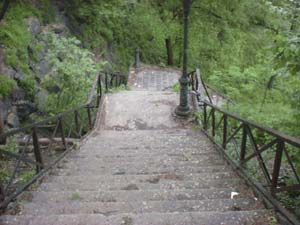 |
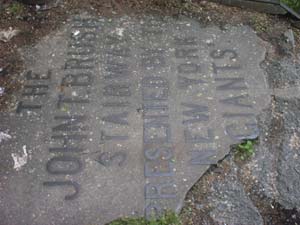 |
A few more absurd and interesting things occurred here. In April 1901, a New York political cartoonist coined the term "hot dog" when he couldn't remember how to spell "dachshund" in describing the "red hot dachshund sausages" served at the game. Anyway, many changes have occurred here over the years and I will try to mention most of them in the next paragraph in chronological order.
The clubhouses were in the outfield as were the bullpens. They were in fair territory. The outfield was slightly depressed so a manager standing in his dugout would only be able to see the top of his outfielders. Coats of arms of all the teams in the National League hung on the outfield walls until they were removed in the 1920s. Dedicated May 30, 1921 to former Giant ballplayer and member of the American Expeditionary Force (A.E.F.), killed in World War I, the Eddie Grant Memorial stood in center field and (obviously) was in play. The memorial read:
In Memory of / Capt. Edward Leslie Grant / 307th Infantry-77th Division/ A.E.F. / Soldier-Scholar-Athlete / Killed in Action / Argonne Forest / October 5, 1918 / Philadelphia Nationals / 1907-1908-1909-1910 / Cincinnati Reds / 1911-1912-1913 / New York Giants / 1913-1914-1915 / Erected by friends in Baseball / Journalism, and the Service.
Slow-footed Harry Danning hit a ball behind the monument and outfielder Vince DiMaggio couldn't find the ball in time resulting in an inside the park home run. In the winter of 1922 to 1923 the concrete double decks of were extended all the way to the new concrete bleachers in center creating the bizarre seating effect. In 1929 they attempted to wire umps to the PA system, that obviously didn't last. During the 1950s, Giants owner Horace Stoneham built an apartment under Section 3 of the left field stands to lure groundskeeper Matty Schwab away from the rival Brooklyn Dodgers. (He could cut some mean grass.) In 1957 a 2 foot square section of sod was taken to San Francisco where the team now plays. Demolition started on April 10, 1964. The same wrecking ball that took down Ebbets Field was used to destroy the Polo Grounds.
The Polo Grounds Housing Project (pictured below) now stands on the site.
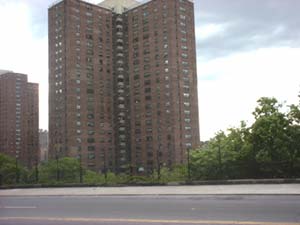
Giants retired numbers (and the year it was retired):
- 4 Mell Ott (1949)
- 11 Carl Hubbell (1944)
© 2002-17 Paul Healey. Photographs of the old stadium © their owners. Used without permission.